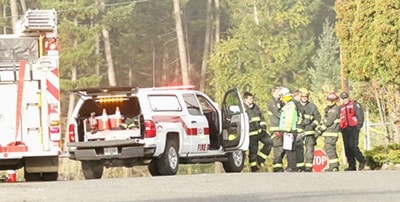100 Mile House Fire Rescue chief Roger Hollander says department members had their hazardous materials training tested in a real incident, and he thought the response went very well.
Around 1:50 a.m. on Sept. 22, Fire Rescue received a callout and responded to a hazardous material spill in the parking lot of Big Country Storage on Seventh Street across from Peter Skene Ogden (PSO) Secondary School.
The spill resulted in the closure of several businesses and PSO on Seventh Street, which was barricaded immediately and wasn’t opened to the public until 9 p.m.
“We’re at a certain level of our hazardous material training, and we certainly exhausted that training on this chemical,” Hollander says.
“So that involved recognizing the chemical involved, keeping a distance away and getting a barricade up, not letting people in, and contacting the appropriate agencies.”
Hollander notes he made 10 to 15 calls during the day because of the different things that were going on.
“I think on our end, it went extremely well. There were multiple agencies working together at one point, so it’s always difficult when there’s lots of people involved.”
The chemical spill was discovered by the driver when he opened the trailer doors and a liquid spilled out of the trailer and onto the parking lot, the fire chief says, adding the driver immediately called in the alert.
When Hollander arrived on the scene, the fire chief says he went over the truck manifest with the driver to see what he was carrying.
They determined the chemical was sodium hydroxide, which is a highly caustic chemical that’s corrosive to metal and tissue and is reactive to water. It is used in items like soap, detergent and drain cleaner; it’s also used in the manufacturing of explosives.
When he learned what he was dealing with, Hollander says he knew it was reactive and dangerous and he called CANUTEC for advice.
CANUTEC is the Canadian Transport Emergency Centre operated by the Transportation of Dangerous Goods (TDG) Directorate of Transport Canada.
“Getting their technical advice over the phone really helped.
“Fortunately, it wasn’t a worse chemical that could have affected a larger area.”
The firefighters had to take some protective measure with the liquid sodium hydroxide as it was pooling and running down the parking lot towards a District sewer drain, the fire chief explains.
“We had to do some damming and diking to block the product from getting [into the sewer] after we identified it.”
He says there was a 250-gallon tote with sodium hydroxide leaking out onto the trailer bed, and while most of it was on the trailer floor, some of it was on the ground.
The fire chief adds the chemical got through a couple of their barriers to stop it from getting into the sewer.
“We had two barriers set up ... and we had to get a truck load of sand from the District to make a stronger barrier.”
The chemical in the trailer was also a concerns for the firefighters.
“Of course, there’s holes in the floor boards of the trailer and the chemical came out through the wheel wells and onto the ground and was
heading towards the sewer halfway down the parking lot,” Hollander says..
“That was one issue we had, but the other issue was the chemical is reactive and it’s highly, highly corrosive. It was reacting to the aluminum frames of the truck and the wheels.
“What it does is within an hour of it sitting there, it turns into a foam.”
Hollander says he was told not to use water on the chemical because it reacts and also generates heat and pressure.
He notes it was unknown what other metals were in the trailer, there was a potential for further reactions.
“CANUTEC noted pressure and heat could have built up and that could cause other concerns for us. So, we had to make sure the trailer doors were open to ventilate it properly.”
Hollander explains they set up fire protection around the trailer.
Noting they took all of the proper precautions, the fire chief says he was pleased nobody got hurt and everyone did what they were supposed to do.
“With the level of training and the abilities we have here, I was quite happy with our training and our response to that scene.”
Firefighters were sent back to the hall at 10:30 a.m., while Hollander remained at the site for 14 hours.
